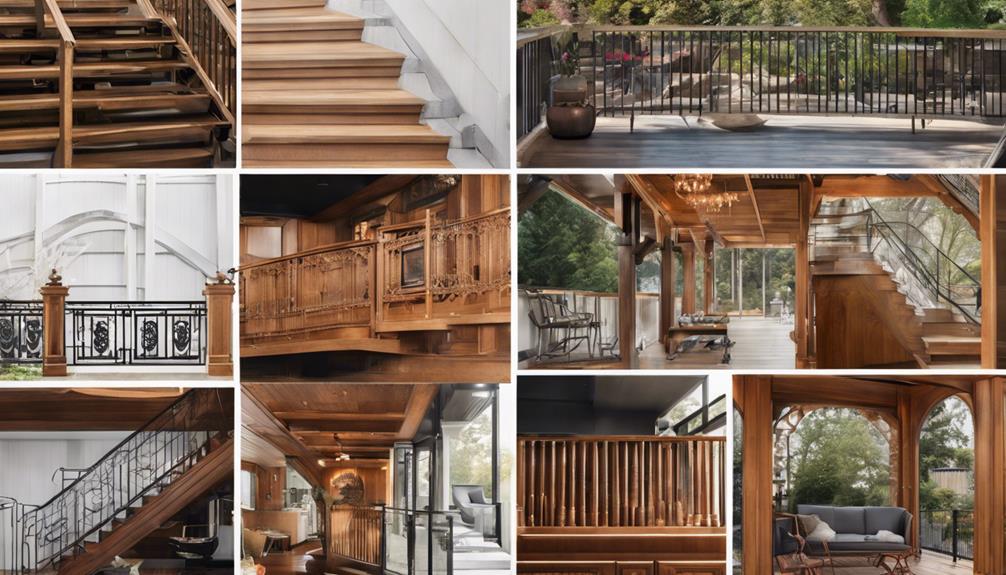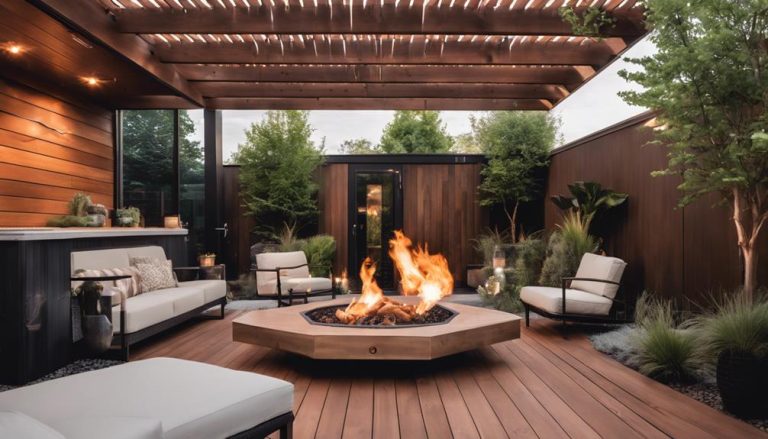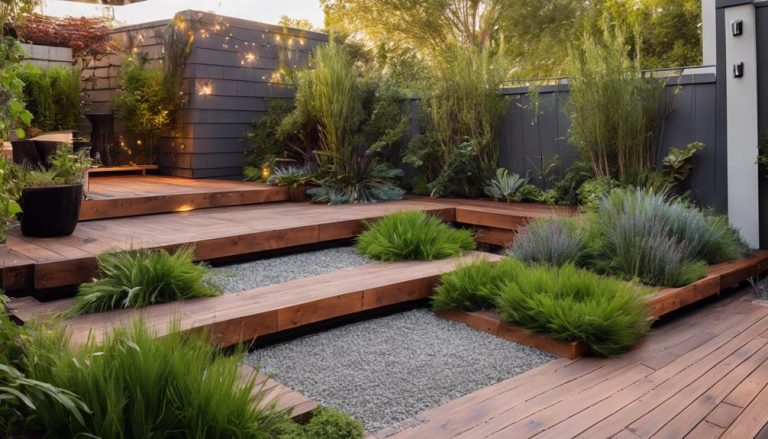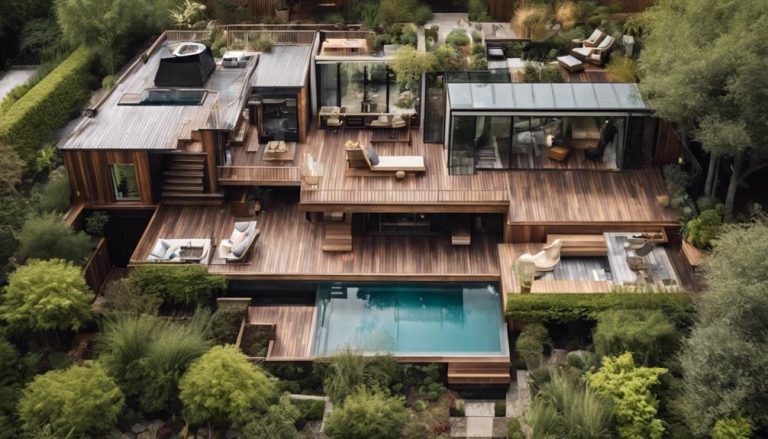Historical Evolution of Deck Designs Over the Decades
Over the decades, deck designs have evolved considerably, driven by innovations in materials, architectural trends, and environmental considerations. The introduction of materials such as composite decking, made from wood fibers and recycled plastics, has greatly enhanced durability and decreased maintenance requirements. Architectural designs now integrate decks as seamless extensions of living spaces, emphasizing open and minimalistic aesthetics. The shift towards eco-friendly materials and designs further highlights the industry's commitment to sustainability, incorporating features like reclaimed wood and solar-powered lighting. These transformations not only meet changing consumer demands but also play a strategic role in enhancing property value and functionality. Explore further to uncover the intricate details of these deck transformations.
Deck Builder Highlights
- Composite decking's rise marked a shift towards durable, eco-friendly alternatives to traditional wood.
- Deck designs now emphasize integrating indoor and outdoor spaces for cohesive architecture.
- Innovations like PVC and bamboo enhance deck durability and environmental sustainability.
- Modern decks offer increased functionality with built-in seating, kitchens, and smart technology.
- Aesthetic evolution reflects contemporary tastes, blending artistic design with practical features.
Deck Design Changes
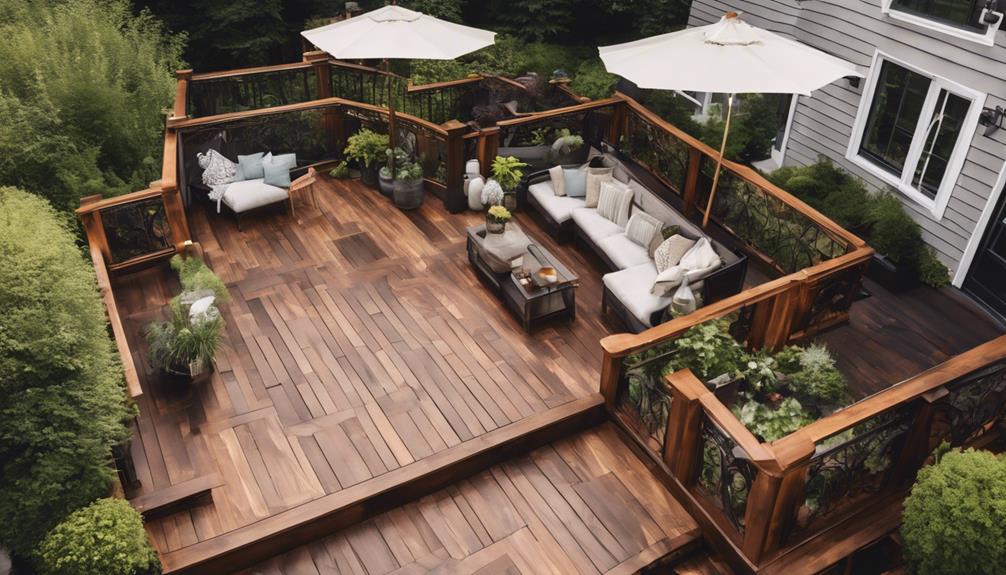
The evolution of deck design has been substantially influenced by advances in material technology, which have allowed for greater durability and aesthetic diversity, while simultaneously adhering to modern trends in architecture that emphasize seamless integration with existing structures.
Additionally, there is a focus on creating decks as living space extensions, blending personal style with home architecture for a seamless deck-home aesthetic. These innovations are further complemented by a growing emphasis on eco-friendly practices, reflecting a broader societal shift towards sustainability that encourages the use of recycled materials and energy-efficient building processes.
As a result, contemporary deck designs balance style, functionality, and environmental responsibility, setting new standards in outdoor architecture.
Material Innovations in Decks
Advancements in material technology have substantially transformed deck design, leading to enhanced durability, sustainability, and aesthetic appeal. As traditional wood inherently suffers from weather-related deterioration, newer materials offer a resilience previously unattainable.
The introduction of composite decking, comprised of wood fibers and recycled plastics, has redefined the industry standard with its reduced maintenance and imperviousness to rot and insect damage. Similarly, PVC decking, composed entirely of synthetic material, further extends deck longevity by resisting moisture and offering diverse color options.
Moreover, the environmental consciousness has driven material innovations, emphasizing sustainability. Bamboo, a rapidly renewable resource, serves as an eco-friendly alternative, offering a sustainable yet visually appealing option with a strength comparable to hardwood without its environmental costs. Additionally, reclaimed wood and recycled materials have gained prominence, minimizing waste and supporting green building practices.
Aesthetic considerations have also been influential in material evolution. Aluminum decking, with its sleek, modern finish, provides a contemporary aesthetic, while also boasting low maintenance and high durability. These innovations collectively enhance the user's investment by ensuring structures that are enduring, stylish, and environmentally responsible, meeting the holistic needs of modern deck design.
Influence of Architectural Trends
Shifts in architectural trends have greatly impacted deck design, steering it towards a more integrated and multifaceted addition to residential and commercial properties. Evolving from standalone structures, decks have become essential components, harmonizing with the architectural vocabulary of current design styles.
Modern architecture has preferred open and minimalistic forms, resulting in decks that extend living spaces seamlessly outdoors, blurring boundaries between interior and exterior environments. This evolution is influenced by contemporary design principles that focus on functionality and aesthetic coherence. Architects now often incorporate decks within the initial building blueprint, ensuring coherence with the property's overall style.
The rise of urban living and high-density residential areas has also instigated adaptive design practices. Multi-family housing developments now incorporate communal decks, serving as social hubs that align with urban aesthetics and space constraints. The integration of glass, metal, and innovative silhouettes reflects modern design trends, allowing decks to serve as focal points that enhance the property's architectural distinctiveness.
In addition, the adoption of asymmetrical lines and natural textures reveals a preference for decks that amplify architectural diversity. As architects continue to explore dynamic design paradigms, decks are crafted to offer both visual appeal and practical versatility, reflecting broader shifts in architectural sensibilities.
Eco-Friendly Design Transitions
Increasingly, eco-friendly design shifts have become a cornerstone in modern deck construction, reflecting a broader commitment to environmental responsibility. This metamorphosis is driven by a confluence of factors, including heightened awareness of ecological impacts and advances in sustainable materials.
Modern designs now prioritize not only aesthetics and functionality but also resource efficiency and reduced environmental footprints. Engineered wood, recycled plastics, and composite materials are prominent in contemporary deck design. These materials offer durability and low maintenance while reducing reliance on traditional timber, which often involves deforestation and significant carbon emissions.
Moreover, sustainable practices extend beyond materials to encompass construction techniques. Builders now focus on minimizing site disturbance and promoting efficient waste management, further underscoring eco-conscious methodologies. The incorporation of native plantings around decks also exemplifies the integration of environmentally sensitive approaches, enhancing biodiversity and reducing water usage.
Additionally, innovative technologies such as solar-powered lighting systems are increasingly prominent, further reducing the carbon footprint of outdoor spaces. Collectively, these eco-friendly alterations not only respond to immediate environmental concerns but also set a precedent for future designs, aligning with broader societal shifts towards sustainability and environmental stewardship.
Benefits

Historical deck designs provide a multitude of benefits that cater to both practical and aesthetic considerations, enhancing outdoor living spaces by blending classical charm with modern functionality. These designs not only increase the allure and enjoyment of residential landscapes but also contribute to improving property value by integrating advanced functionality features. Unmatched Expertise guarantees that projects meet contemporary standards while retaining timeless visual appeal.
This convergence of form and function certifies that well-designed decks serve as treasured extensions of indoor spaces, offering versatile areas for entertainment and leisure. Additionally, specialization in creating weatherproof and long-lasting outdoor spaces boosts their usability across different seasons.
Increased Outdoor Living Space
Transforming a traditional deck into an extended outdoor living space comes with a multitude of benefits that considerably enhance both the functionality and aesthetic appeal of a home. An expanded deck provides homeowners with additional square footage that can serve multiple purposes, ranging from hosting social gatherings to offering a tranquil retreat for private relaxation. By capitalizing on existing outdoor areas, homeowners can effectively maximize the utility of their property, fostering an environment that seamlessly bridges indoor and outdoor living.
This increase in usable space often encourages greater engagement with the natural surroundings, promoting a healthier lifestyle by providing an accessible venue for outdoor activities such as dining, exercise, or even cultivating a garden. Consequently, an expansive deck enables the integration of various functional features like outdoor kitchens, seating areas, or designated zones for entertainment systems, enhancing the versatility and practicality of the space.
In terms of property value, the addition of a larger outdoor living area is a strategic investment. It not only increases curb appeal but also meets the growing consumer demand for adaptable living environments that cater to diverse needs. In sum, such a transformation offers significant enhancements to daily living experiences.
Enhanced Aesthetic Appeal
A redesigned deck offers multiple aesthetic benefits that greatly elevate the visual appeal of a property. Contemporary deck designs provide an array of stylistic enhancements that draw the eye and complement the architectural details of a home.
Modern materials such as composite decking, available in a diverse palette of colors and textures, mimic the natural beauty of wood while offering the added advantage of durability and minimal maintenance. This guarantees that the deck not only retains its aesthetic charm over time but also remains an enduring element of outdoor elegance.
Beyond materials, the incorporation of intricate design features such as railings with glass panels or metal balusters, integrated lighting, and built-in planters can transform a conventional deck into a bespoke outdoor gallery. These elements serve as focal points that harmonize with the surrounding landscape, enhancing the property's overall curb appeal and potentially increasing its market value.
As homeowners seek to create picturesque outdoor havens, the aesthetic versatility of modern deck designs provides a plethora of options that cater to diverse tastes, from minimalist to ornate. Consequently, the evolution of deck designs underscores an ongoing commitment to blending functionality with an artistic vision that elevates residential aesthetics.
Improved Functionality Features
While the aesthetic enhancements of a deck are undeniably important, the improved functionality features cannot be overlooked. Decks have evolved beyond mere outdoor extensions to become integral parts of modern living spaces, characterized by their adaptability and versatility.
Features such as built-in seating, outdoor kitchens, and integrated lighting solutions have heralded a paradigm shift in the design philosophy of decks, transforming them from conventional spaces into places of multifaceted utility. Homeowners now enjoy personalized environments that cater to a range of activities, from family gatherings to quiet solitude.
Incorporating advanced materials like composite decking not only enhances durability but also minimizes maintenance, consequently facilitating a more enjoyable experience. Innovative designs like multi-level decks or those with retractable canopies showcase adaptability to various climates and terrains, ensuring usability throughout the year.
Additionally, smart technology integrations, including weather monitoring systems and app-controlled lighting, augment the practicality of decks, fostering a seamless interaction between technology and outdoor living.
Such enhancements, conceived with a focus on user experience, have underscored the fundamental evolution of decks. They reflect a nuanced understanding of contemporary lifestyle needs, offering tailored solutions that marry both form and function in sophisticated harmony.
Boosted Property Value
Beyond the immediate aesthetic and functional benefits, enhancing your deck can markedly boost property value. A well-designed deck is an architectural investment that potential buyers find appealing, as it extends the living space and provides a cohesive shift between indoor and outdoor environments.
Historically, as homeowners have increasingly prioritized outdoor living spaces, decks have evolved from mere platforms into sophisticated extensions of the home, complete with amenities that rival indoor rooms.
Such enhancements can include built-in seating, outdoor kitchens, and weather-resistant materials, all of which increase curb appeal and command higher market prices. According to real estate experts, properties with modern, updated decks often see a significant return on investment upon sale, primarily due to enhanced visual appeal and additional functionality they provide.
Deck designs reflecting current trends or utilizing sustainable materials attract eco-conscious buyers, offering an edge in competitive real estate markets. In addition, a deck that is well-maintained and professionally constructed demonstrates the home's overall quality.
Composite Materials Introduction
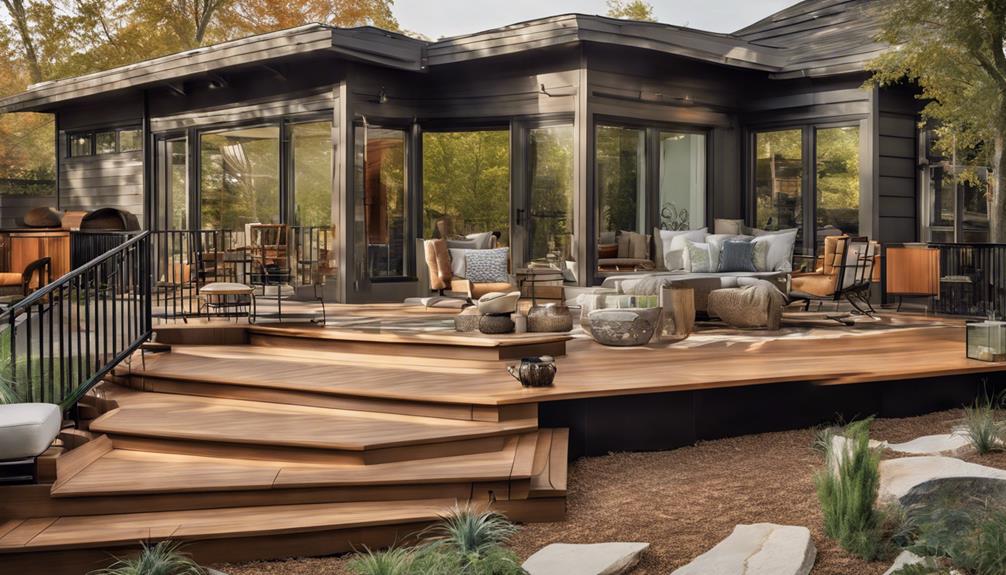
The evolution of deck design has experienced a significant shift with the advent of composite materials, which have gained popularity due to their superior advantages over traditional wood, such as enhanced durability and reduced maintenance requirements. As technology has advanced, composite decking has evolved to offer a more diverse range of aesthetics and performance options, addressing environmental concerns and improving structural integrity. To better understand the distinctions between traditional and composite materials, consider the following comparison:
| Aspect | Composite Materials |
|---|---|
| Durability | High |
| Maintenance Needs | Low |
| Aesthetic Variety | Broad |
| Environmental Impact | Reduced |
| Longevity | Extended |
This concise comparison underscores the growing preference for composite materials in contemporary deck design.
Rise of Composite Decking
Emerging as a pivotal innovation in the decking industry, composite decking has transformed outdoor living spaces through its blend of functionality and aesthetics. Introduced in the late 20th century, composite decking was designed as a robust alternative to natural wood.
Manufactured from a combination of wood fibers and plastic, this material presents a dual advantage of enhancing durability while offering environmental sustainability, as many components are sourced from recycled materials. The introduction of composite decking not only addressed the common issues associated with wood, such as warping and splintering, but also offered homeowners a diverse palette of colors and textures, closely mimicking the rich appearance of natural lumber.
As composite materials gained acceptance, advancements in technology further improved their performance attributes. Early iterations of composite decking offered basic designs; however, continuous innovation led to enhanced weather resistance and improved ease of maintenance. These developments catered to the evolving preferences of homeowners who desired both resilience against the elements and effortless upkeep.
Composite decking's engineered construction eliminated many constraints previously faced by traditional wood decks, enabling more ambitious architectural designs. This rise marked a significant milestone in deck building, broadening the scope of possibilities for both designers and homeowners.
Benefits Over Traditional Materials
As composite decking established itself as a revolutionary option in the market, its advantages over traditional materials became increasingly evident. Unlike conventional wood decking, which is prone to weathering, splintering, and high-maintenance demands, composite materials offer durability, longevity, and ease of care.
Composed of a blend of wood fibers and recycled plastics, composite decking results in highly resistant structures that withstand environmental stressors like moisture, UV rays, and temperature fluctuations. This resilience substantially reduces the need for regular upkeep, consequently representing a cost-effective solution over time for homeowners and builders alike.
Furthermore, the aesthetic versatility of composite decking cannot be understated. With manufacturing processes allowing for a spectrum of colors and grain patterns, composite materials emulate the natural beauty of wood while providing a uniform appearance and finish resistant to fading. This quality fosters a plethora of design possibilities, accommodating modern preferences for both naturalistic and contemporary styles without compromising structural integrity.
Another compelling benefit is sustainability. The use of recycled materials in composite decking production aids in reducing deforestation and plastic waste, contributing to a more eco-friendly construction industry. Consequently, composite decking triumphantly combines functionality with environmental consciousness, offering a robust alternative to traditional decking materials.
Advances in Composite Technology
Innovations in composite technology have substantially evolved over recent years, continually fortifying the material's performance and sustainability. These advancements focus on improving the structural integrity, environmental impact, and aesthetic appeal of composite materials, making them an increasingly popular choice for modern deck designs.
Among the most significant improvements is the introduction of high-performance additives and innovative manufacturing techniques, which have resulted in more durable and versatile products. As engineers continue to push the boundaries of what composites can achieve, homeowners and builders benefit from an ever-expanding array of possibilities.
Highlighting specific areas of advancement can provide insight into how these materials meet contemporary demands:
- Recycled Content: Using recycled materials reduces environmental impact and conforms to sustainable building standards.
- Enhanced Durability: Improved resistance to weather, insects, and physical wear guarantees a longer lifespan compared to traditional materials.
- Aesthetic Variety: A wide range of colors and textures now allows for more personalized and appealing deck designs.
- Low Maintenance: Minimal upkeep requirements translate into significant time and cost savings for property owners.
- Eco-friendly Production: Modern processes aim to lower emissions and resource consumption during manufacturing.
Such innovations illustrate how composite technology is shaping the future of deck design, balancing practicality and sustainability.
Decks FAQ
What Are the Key Cultural Influences on Deck Designs Over the Decades?
Key cultural influences on deck designs include shifts in social lifestyles, technological advancements, and environmental consciousness. These factors led to diverse styles, integrating functionality, aesthetics, and sustainability to align with evolving societal values and architectural trends.
How Has Climate Impacted Deck Design Choices Historically?
Climate has profoundly influenced deck design through material selection, structural considerations, and orientation. Variations in temperature, precipitation, and UV exposure dictate the use of weather-resistant materials and region-specific design modifications to enhance durability and functionality.
What Role Did Economic Shifts Play in the Evolution of Deck Designs?
Economic shifts influenced deck designs by altering consumer preferences and materials availability. Recessions often led to simpler, cost-effective designs, while economic booms encouraged elaborate, luxury features, reflecting the economic context's impact on resource allocation and consumer priorities.
How Did Technological Advancements Influence the Way Decks Were Built?
Technological advancements greatly enhanced deck construction through the development of durable materials, precision engineering tools, and computerized design software, resulting in improved efficiency, reduced costs, and the ability to create complex, customized designs with greater structural integrity.
What Historical Deck Designs Are Still Popular in Modern Times?
Certain historical deck designs, such as the classic colonial, rustic farmhouse, and Victorian styles, maintain popularity in modern architecture. These designs offer timeless aesthetics, combining traditional charm with contemporary functionality to suit a variety of architectural tastes.

